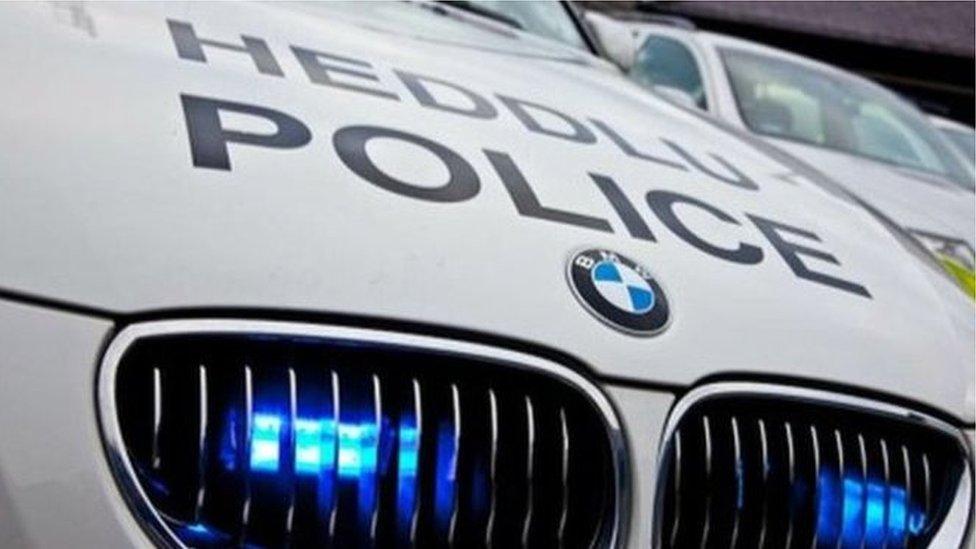Driven to his death: Mystery of motorcyclist body on M4
- Published
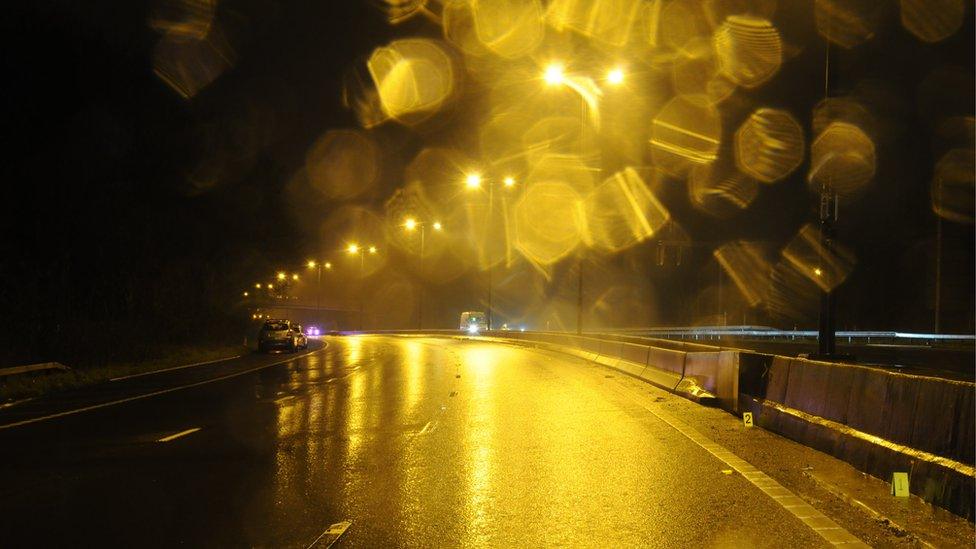
A motorcyclist is found dead on the central reservation of the M4. Piecing together his final moments proves to be a painstaking challenge for The Crash Detectives.

David Evans had been working the Christmas Day shift monitoring CCTV at a power station on the south Wales coast.
In a gesture of seasonal goodwill, a colleague had told him to leave early and get home to his family; he'd take over from here.
As Mr Evans, 49, set off on his Honda CB 500 motorcycle for the hour-long ride home in the wind and rain, his wife and two young daughters were putting the finishing touches to Christmas dinner, awaiting the familiar rumble of his bike pulling up outside.
The call came through to the police control centre 40-or-so minutes later at about 18:00 from a member of the public.
"Just before junction 24 eastbound on the M4," he said. "There's a motorbike right against the central reservation… It's actually on the floor. But there's no sign of the driver."
Bob Witherall, a forensic collision investigator, was with his family finishing his turkey dinner at home when he heard the report go out over his police radio.
When he arrived at the scene the motorway was shut, a stream of backed up headlamps stretched further into the distance by the second, frustrated motorists sighed and drummed their fingers on steering wheels. They had places to be - the long-awaited sanctuary of home, family and friends to visit, Christmas dinners to be eaten.
He was told the motorcyclist had been located.
He had been thrown some 100m and was lying close to a lamppost in the void between the concrete girders of the central reservation. He had hit the concrete pillar after being thrown from his bike. He was dead. He was one junction away from home.
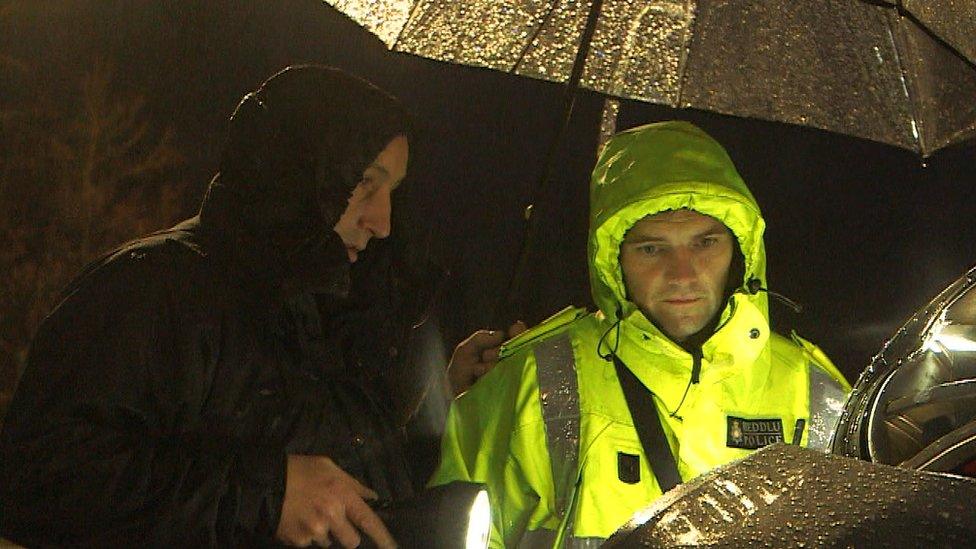
Collision investigator Bob Witherall (right)
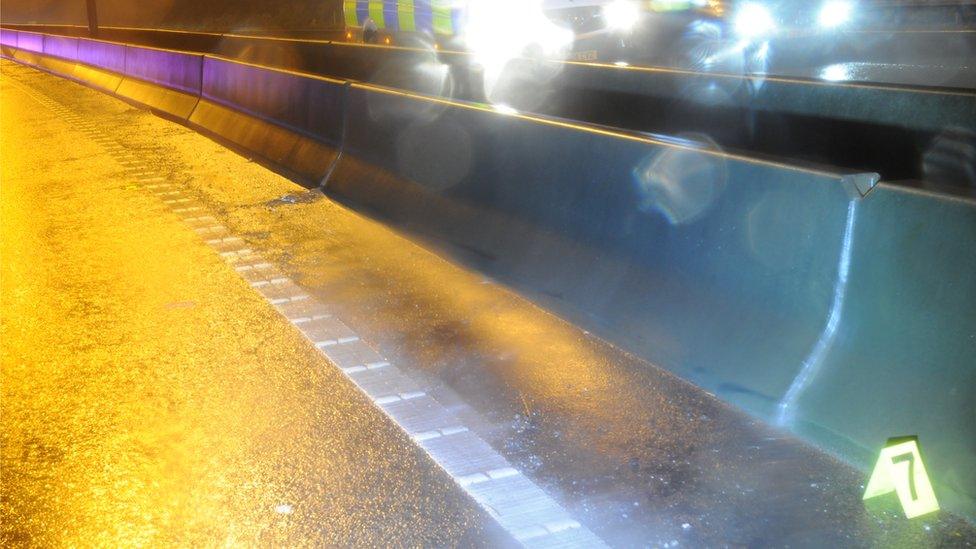
The incident features in Crash Detectives, filmed, produced and directed by BBC Wales' Jenny Casterton
"What I found was a vast scene of about 400-500m along the motorway with debris and marks all along the central reservation," Bob says.
"A vast, complicated scene made even more poignant by the fact it was Christmas Day."
Every fatality on UK roads is treated as a suspicious death and Bob had "one shot" at a forensic examination before the road re-opened and crucial clues were lost forever.
The investigators are under constant pressure to do their job efficiently and quickly; it is estimated that every hour the motorway is closed costs the economy £1m.
Walking around the debris, making his initial assessment, one question looped over and over in his mind - why would a motorbike just collide with the central reservation for no apparent reason?
"I'm not sure what it was about the scene," Bob says, "but at the time I recall saying that it didn't feel right".
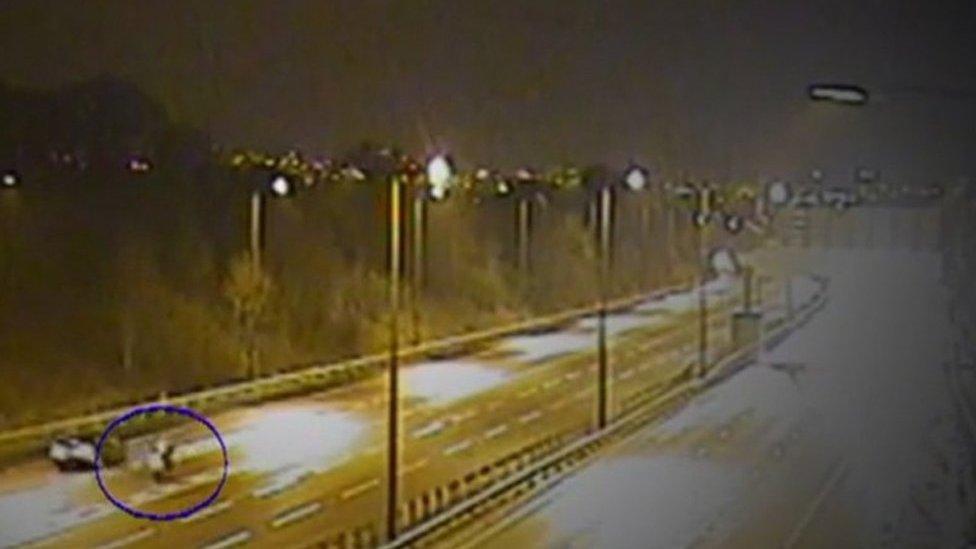
The motorcyclist is seen making good progress shortly after leaving work
A self-confessed 'petrol head', Bob had joined up as a patrol officer on road policing some 10 years before, and part of the family liaison element of that role is breaking the news of road deaths to loved ones and being there for them in the aftermath. He at least had some idea of that grief, having lost a friend in a crash when he was a teenager.
Then, three years ago, he had fulfilled his ambition of becoming a forensic collision investigator, like his father before him who had helped set up a dedicated Collision Investigation Unit at Gwent Police 17 years previously.
As a boy he would listen in awe as his dad relayed stories of high-speed car chases. The "family business" was one he took great pride in.
"There may be no evidential marks at the scene which allow you to find out what happened - there aren't any witnesses or CCTV and sometimes it's frustrating," he says.
"I like to get to the bottom of things, like to find out the truth, to pull the puzzle together and find out what has happened. I enjoy the puzzle and putting the final pieces into place. And when that final piece is missing, it is difficult."
The motorcyclist's death was a case in point. It would prove one of the most challenging of his career to date.
A collision on one of the busiest stretches of motorway in the country, CCTV was thankfully an option.
"We went through it, and immediately picked up the motorcycle and then just prior to the collision picked up a car that was travelling very close to it...
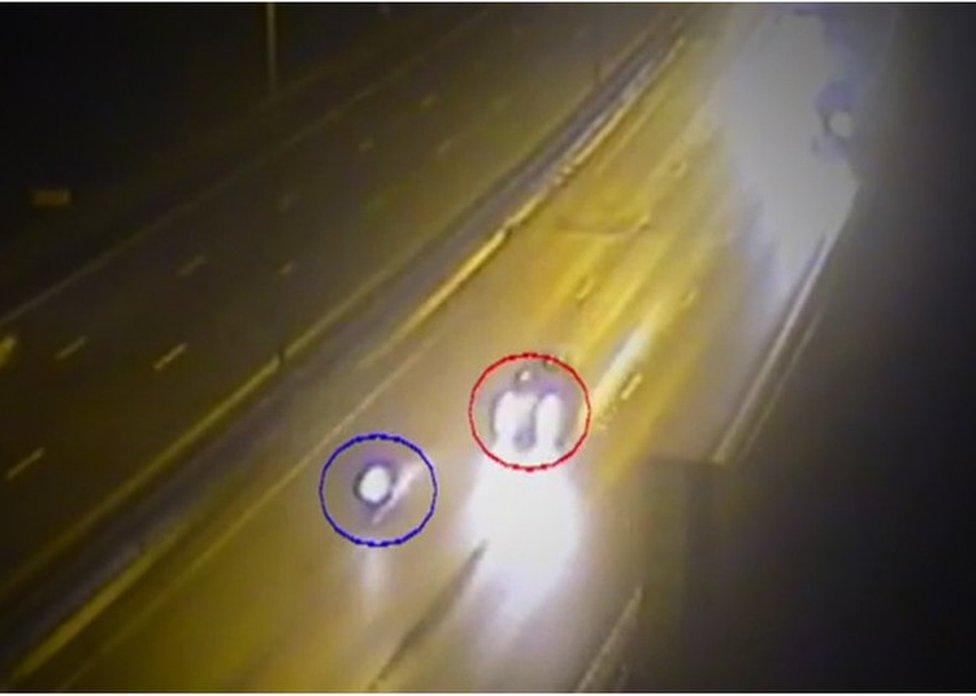
"And at that point these vehicles go out of shot on the CCTV which is immediately prior to the point of collision. These vehicles are literally side-by-side which immediately started alarm bells ringing.
"That feeling I had about this second vehicle, another vehicle being involved… now there was some evidence that might be the case. So the question's asked 'has this bike crashed because of this other car?'"
Colleagues set about the painstaking task of analysing the video, frame by frame, and picked out the car's distinctive headlights and a black roof, deducing the vehicle could be a Mini.
Automatic number plate recognition technology was then used to trawl the records to detect if any Minis had passed the cameras around the time of the crash.
They found a possible match - a car belonging to a local man, Nigel Sweeting, a 49-year-old factory worker and father of two.

Shortly after it joins the M4, a white Mini is seen travelling through the Brynglas Tunnels in Newport
Three days after the crash, he was arrested on suspicion of causing death by dangerous driving and failing to stop at the scene of an accident.
"I don't understand," he told police on the way to the station. "I have not hit anything. I hope I didn't cause anything."
That night, he told interviewing officers, he had driven a short distance, about four miles, to pick up his girlfriend from her waitressing job at Newport's Celtic Manor Golf Resort.
That afternoon he had visited his children, a grown up son and daughter. They had chatted and eaten mince pies, no arguments, no drinking. Then at 17:30 he left "feeling happy" to collect his partner, arriving at the hotel at 17:55.
Was there anything significant about this journey? "Yes," he replied.
What did he remember? "Motorbike trying to swap lanes," he said.
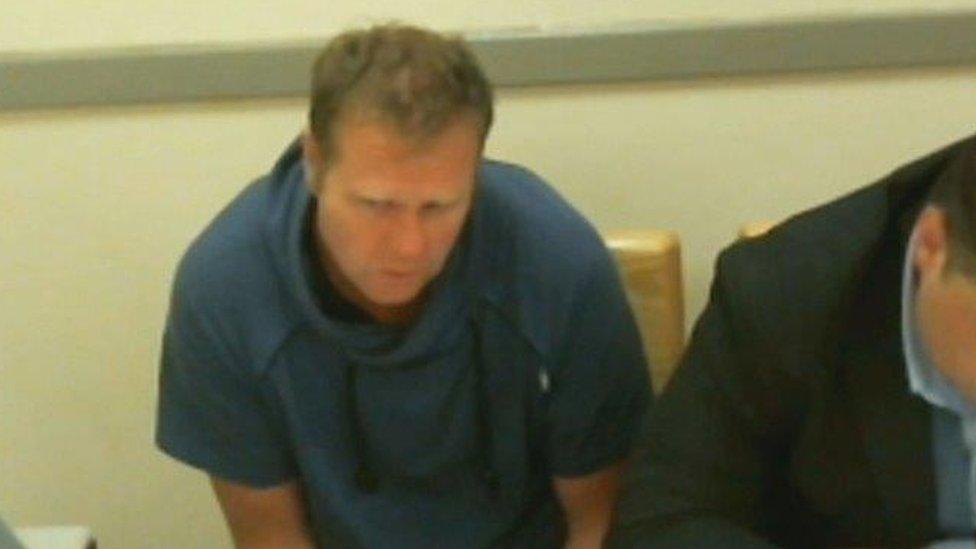
When interviewed by police, Sweeting insisted he was a "slow, calm driver"
The road was busy, he said, the weather treacherous, with hammering rain so heavy his windscreen wipers were on the fastest setting. He was driving slowly, his maximum speed about 60mph.
The radio was on; he had just tuned into Heart FM which was playing Christmas songs. The volume was not loud, just a normal level.
Sweeting told officers he did not have any medical conditions, did not need glasses for driving, just for reading, and considered himself a good driver "a slow, calm driver… doesn't rush anywhere".
Driving in the fast lane he said he noticed a motorbike come up beside him which seemed to "swerve a little bit" as if the rider had gone to pull out into the fast lane without checking it was clear.
That was the first he had seen of the motorbike, he insisted.

When pressed, he said he recalled being a bit frightened and had taken his foot off the accelerator, dropping down to 55, maybe 57mph, before accelerating away.
"I just carried on with my journey," he said, assuming the bike had "backed off". He was adamant he did not see it again as he turned off the M4 just a few hundred yards on at the next junction.
"Did you see a collision involving a motorbike on the 25.12.2015?" he was asked.
Without hesitation, Sweeting shrugged and replied: "No."
By this stage Bob had begun an inspection of the impounded white Mini. There was a dent on the near-side wing and a long scratch mark along the side which looked like it might have been re-touched.
"The whole car itself is covered in a traffic film of dirt other than this area which has quite recently been cleaned," Bob says. "You've still got the sweep marks where he's been cleaning it. So the question is: Why has he just cleaned one side of his car?"
Lining the motorbike up with the Mini, the mark was "bang on" the height of the motorbike's red-trimmed, hard plastic pannier. On closer inspection of the dent, Bob found minuscule traces of red paint.
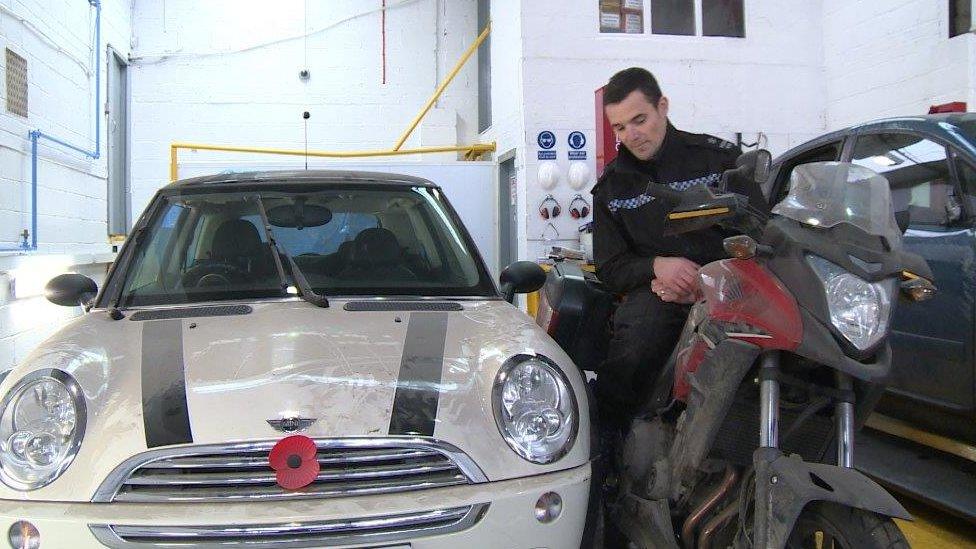
Sweeting's explanation? The car was damaged by a "psycho ex" who had keyed the bodywork and kicked off his wing mirror, which was now strapped on with tape.
At least that was the initial explanation - it would change over subsequent interviews - someone had driven into him or he had driven into a bush.
And what about traces of red paint found on the dent? Residue from a kitchen scouring pad he'd used to clean the area before applying some colour restorer and varnish some months before.
"Immediately I thought there'd been a collision between the two which would have resulted in the collision with a motorcycle in the central reservation," Bob says.
"Obviously it's my job to probe that, or to locate the evidence to prove that's the case which started this massive forensic investigation in terms of trying to match the red paint found on the car to the red paint of the motorcycle.
"He tried to clean it but hadn't done quite enough of a good job of it. I think had we not identified the vehicle so quickly he may have taken some more measures to do a better job but it was a very crude attempt to try to rid the damage."
Hopeful of a breakthrough, the tiny paint scrapings were dispatched for analysis. But there was bad news. The residue of red paint was not sufficient to conduct laboratory tests to confirm a match.
"It was a bit of a blow," Bob says. "You know… it's not just a crash, it's not just a bump. Someone has died and we will find out why that person has died and I'll go to the nth degree. I wasn't going to stop there."
Sweeting was released from custody.
As the investigation continued over weeks and months, his primary concern appeared to be getting his car back. His repeated requests for its return were turned down.
So in terms of evidence, it was back to the drawing board.
Bob returned to the CCTV. Earlier that evening the footage showed Mr Evans riding along "no issue at all".
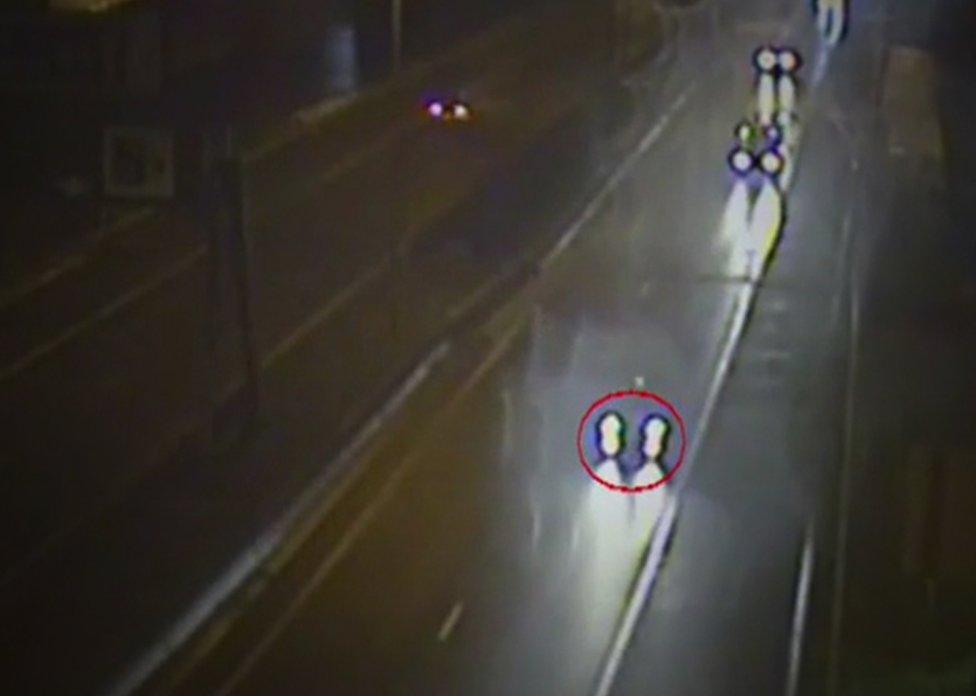
Sweeting "plodding along" at 52mph shortly before being overtaken
Marking the timings of when both of the vehicles were located on CCTV, he used a computer system to calculate the speed they were travelling at.
Mr Evans is travelling at an average speed of 72mph between junctions 27 and 26.
Sweeting's Mini has joined at junction 26 and is "plodding along" with the traffic at an average speed of 52mph.
Before long the motorbike catches up with the Mini. He overtakes. And it is at this point that the picture quickly changes.
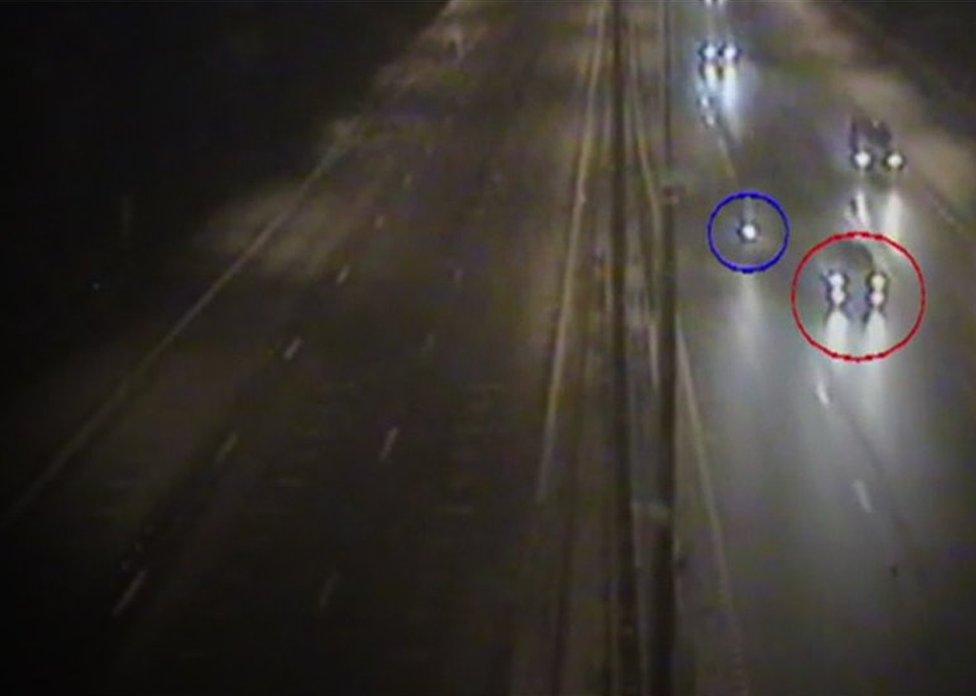
Critical moment: The motorcyclist is seen about to over take the white Mini
"They start to accelerate; they start to get a bit quicker. The bike comes out to overtake the Mini, they start to accelerate," Bob explains.
"Now the Mini is in close proximity to the bike… less than half a second."
Before long the average speed of both vehicles reaches 86mph.

"Just prior to going out of shot, they are literally right next to each other. It looks like the Mini is right next to the bike in lane three. Unfortunately in the next half a second they disappear and the collision happens… we just miss it on camera."
The Mini is seen emerging through the next section of CCTV coverage, there is no trace of the bike.
Just a second after disappearing from CCTV view, Mr Evans has been killed.
In June, six months after the collision, Sweeting is brought in again for interviewing and is confronted with the footage.
It is obvious the bike had been travelling in front of the Mini for some time and in very close proximity but Sweeting remains adamant, he never saw the bike until it pulled alongside him and swerved.
Why had he accelerated so dramatically to an average speed of 86mph? "I didn't realise I was," Sweeting says, shaking his head in apparent confusion.
Had the motorbike angered him by overtaking? Did he want to catch him up? "No."
A woman who had been driving along the M4 that night with her husband recalled a Mini passing at speed, driving dangerously close to the bike, probably only a foot apart. She recalled calling the driver of the Mini "an idiot".
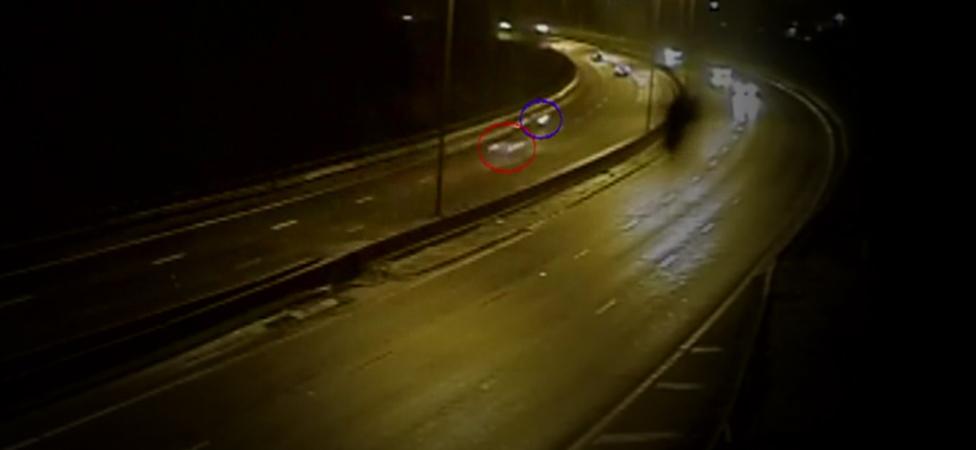
The vehicles move out of view. The next thing she sees of the bike it is spinning clockwise on its side in the near distance. She screamed at her husband who swerves to avoid it, the bike still spinning as they pass.
When pressed if he had seen anything resembling this scene, Sweeting replies: "Nothing, no sparks, nothing."
It is the first time anyone has mentioned sparks.
He says he picked up his girlfriend and knew nothing about the fatal crash until officers called at his home to arrest him.
But his then-girlfriend told police after Sweeting was first arrested: "Nigel did not mention anything that day and has not mentioned anything to me about the accident on the motorway.
"I saw there was a fatal accident on the M4 motorway on Christmas on the Argus (local newspaper) website and I asked Nigel if he had seen it whilst picking me up because the police were looking for any witnesses.
"He told me 'no' as far as he was aware he had not seen anything."
Just like everything else, Sweeting responded to her account with the now familiar refrain - "I don't know… I can't remember."
But he was about to be confronted with some irrefutable evidence of exactly what did happen the second the two vehicles were lost on CCTV.
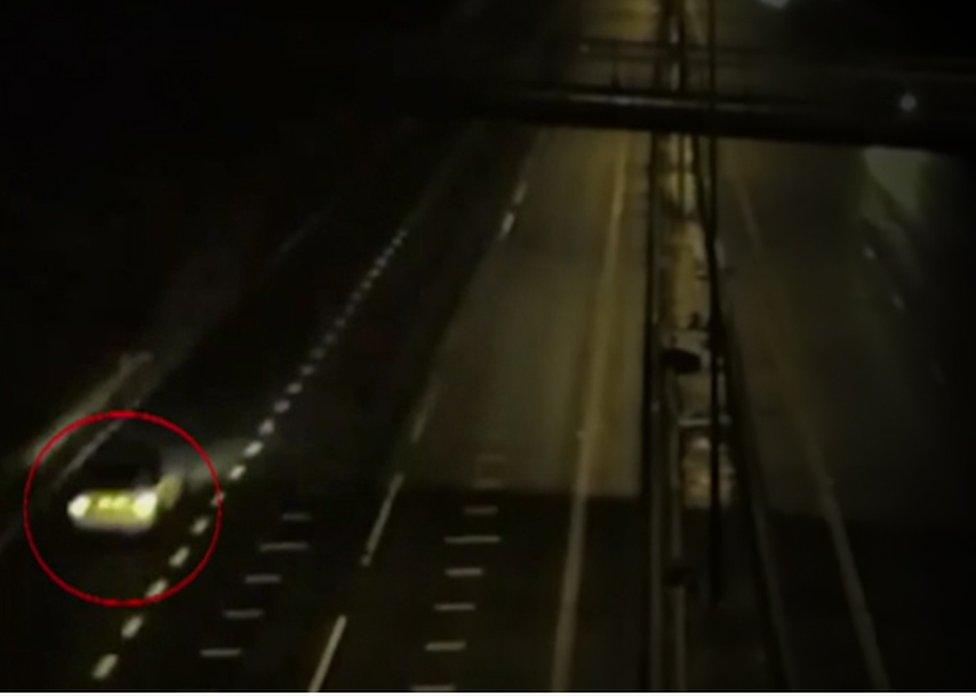
Sweeting's car is captured on the next CCTV; there is no sign of the motorbike
Undeterred by the lack of results from the marks of red paint on the Mini, Bob took another look at the motorbike foot peg which had been ripped off in the collision and retrieved from the carriageway.
He had already matched its height to possibly fit with scuff marks around the vehicle's alloy wheel.
"We looked at the foot peg and under a magnifying glass found these very faint traces of black material," he said.
"I first thought it was road grime, dirt. And then we found this very faint trace of orange within the black paint. But it was an aluminium foot peg so it couldn't be rust… there was an orange undercoat on the black alloy of the Mini so I thought 'that's a bit of a coincidence'."
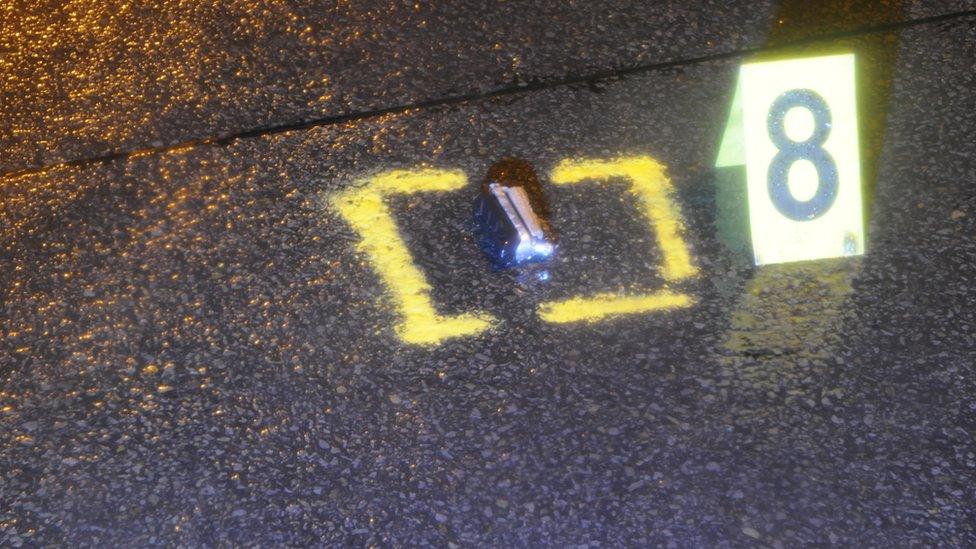
The motorbike foot peg found at the crash scene
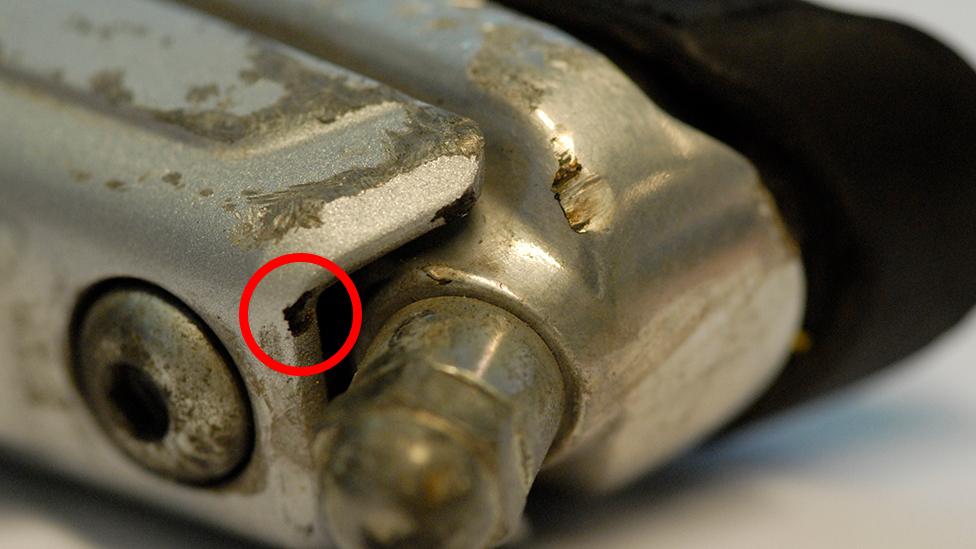
Bob set off with the wheel and foot peg to a forensic laboratory at Sheffield Hallam University to see if it could be proved scientifically that the orange paint on both items was a match.
"I've tried numerous things so far and they've all turned out to be inconclusive," Bob said. "I just want to get to the bottom of what's happened. I'm convinced this vehicle's involved. I just need to prove it.
"This was the last throw of the dice really, in terms of forensic opportunities."
Chris Sammon, a professor of polymer science, used infrared spectroscopy to get a reading of the paint samples on both items.
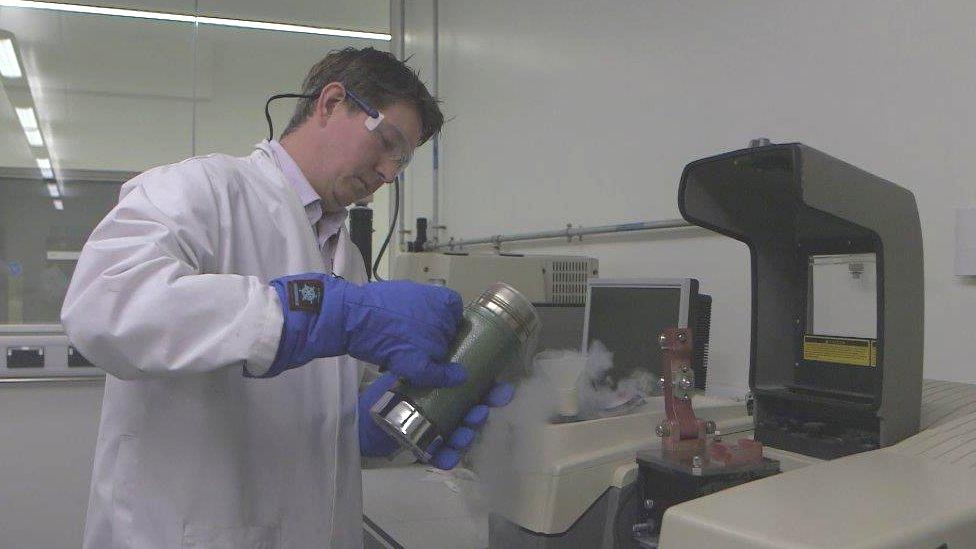
Prof Chris Sammon at Sheffield Hallam University
There was no question; the paint was a definite match.
Bob now had indisputable evidence linking the two vehicles.
Under police questioning, Sweeting finally admits contact with the motorcycle could have been a possibility but, again, says he cannot remember. If it happened he was not aware of it.
Pleading not guilty to the charges against him - causing death by dangerous driving and attempting to pervert the course of justice - Sweeting went to trial at Newport Crown Court in May last year.
The court heard he had been warned not to drive by his optician because of a problem with his peripheral vision. He had been given a referral letter to give to his GP. When asked why he had not seen his doctor, Sweeting had said he "couldn't be bothered".
His defence barrister called the charges "a reaction to something appalling that has happened and nobody wants a death to go unmarked".
"Looking for scapegoats is in our nature," he said.
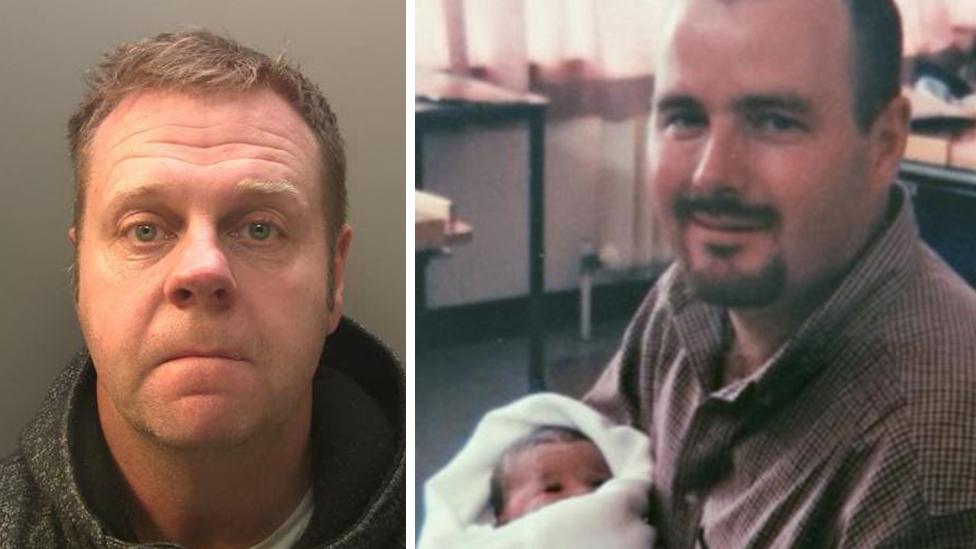
Nigel Sweeting was jailed for causing the death of David Evans
He added that Sweeting had been diagnosed as depressed and had suffered while serving as a soldier in Northern Ireland some years before.
"He is a man who bears scars," he said. "He cannot cope with working. He cannot cope with many things.
"He cannot cope with the enormity of December 25, 2015."
Mr Evans' elder daughter, Isabella, told the court of her difficulty in coping with the enormity of that day too as she read aloud her victim impact statement.
"I relive throwing his Christmas dinner in the bin, every Christmas Day will remind me of that," she said.
"Since he has gone, no-one is the same. Everyone is a ghost of themselves.
"I feel the loneliest I have ever felt, despite having all my family around me. My dad, David Evans, was and still is mine and my sister's hero.
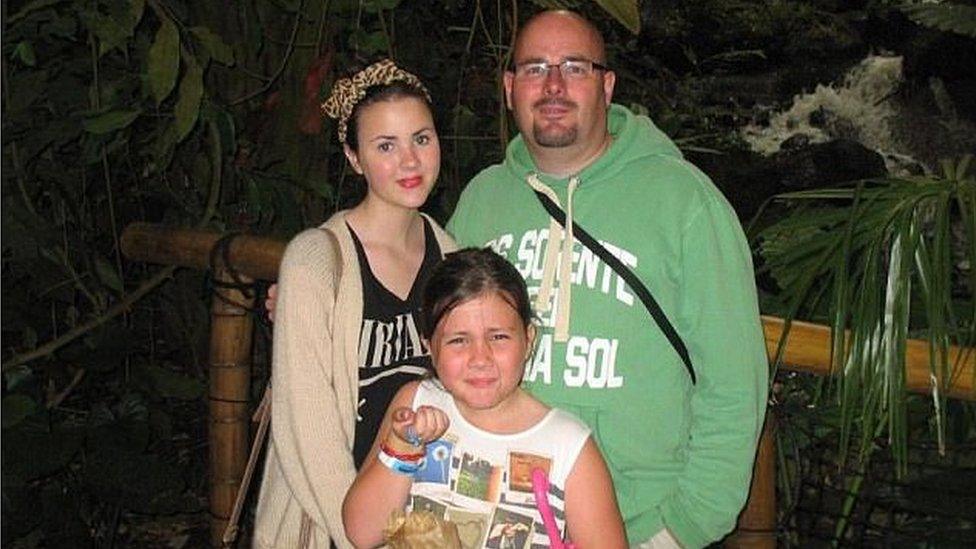
David Evans with his daughters Isabella (left) and Evie
"He was such an amazing man and a loving husband. Anyone who ever met him would tell you what a funny, kind hearted and hardworking man he was."
A statement read out on behalf of Mr Evans' wife, Rachel, said: "On Christmas Day 2015, my life changed forever. David was a perfect husband and the most brilliant dad.
"I thought me and David would grow old together. He always said to me our time would come."
And if anyone in the court was in any doubt as to what had happened the evening of Christmas Day 2015, Judge Daniel Williams provided excoriating clarity.
Sentencing Sweeting, he told him: "You knew there had been a collision and you left David Evans by the side of the road. This trial was focused on the actions of that day, it's time this court focuses on the consequences of these actions.
"You caused the death of a trusted father to his two daughters, prized friend and companion to many others; a proud, hardworking man with an infectious sense of humour."
'Horrendous, dangerous pursuit'
Referring to the moving words of Mr Evans' daughter Isabella, he added: "You have deprived those people of that man. I have seen you give evidence. It's clear you feel no remorse at all, just odious self-pity.
"Your staged apology to this whole room was entirely hollow. If you are motivated by anything other than self-motivation you would have admitted what you have done. Not made this process longer by your decision to contest guilt.
"You were driving along the M4, driving within the speed limit. Whether this caution was because of being over the legal limit to drive, we will never know.
"He was travelling quicker than you, and overtook you. That was enough for you to embark upon a horrendous, dangerous pursuit.
"It would appear your ego is so frail that the mere fact of being overtaken was too much to withstand.
"This was an aggressive course of driving intended to intimidate and bully David Evans. Your past suggests that bullying is in your nature.
"You accelerated harshly, going from 52mph to 86mph in a pursuit of the bike. You must've dropped down the gears and accelerated hard.
"You exaggerated the poor weather conditions to say you were not aware of the collision.
"One can't imagine how David Evans felt in the moments before the collision. You were travelling along behind him at great speed, less than half a second behind his rear wheel.
"You drove into him, clipping his foot peg, causing him to lose control and in the resulting collision, lose his life.
"You know you contributed to his death. Having driven him off the road, and to his death, you drove off. Even for someone with your record for dishonesty, this was absolutely shameful.
"Your yearning for self-preservation was sickening... You drove off and went to remove the evidence that proved you had been in a collision.
"No sentence can recompense those who have lost David Evans or undo the wrong."
Sweeting, of Bettws, Newport, who had had 21 convictions across 35 offences dating back to 1979, was given seven years in prison for death by dangerous driving, 12 months for attempting to pervert the course of justice, and was disqualified for driving for six years.
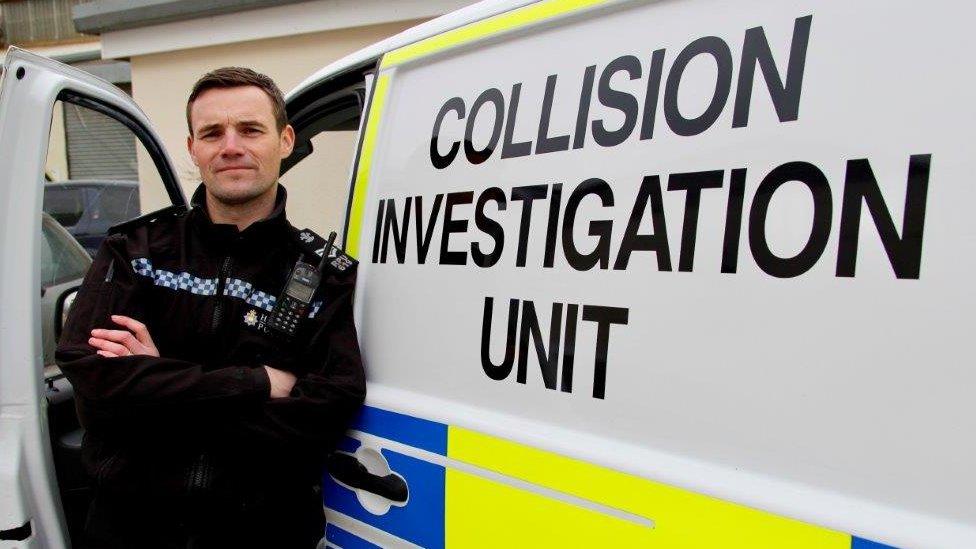
Bob Witherall was given a chief constable's commendation for his work on the case
For Bob it was one of the most challenging yet, given the outcome, the most rewarding cases he had worked on.
"Sweeting didn't think he would face so much overwhelming evidence," he said. "I don't think he realised the lengths we go to get to the truth.
"For me the most important thing is getting to the truth and getting justice for the family.
"It won't change things for them, they can't bring their husband and father back but hopefully it will just answer some of the questions they may have had.
"There's no two ways about it. The driver of that car has intimidated and bullied this motorcyclist and has driven him to his death."
The Crash Detectives on BBC iPlayer
- Published11 May 2017

- Published29 December 2015
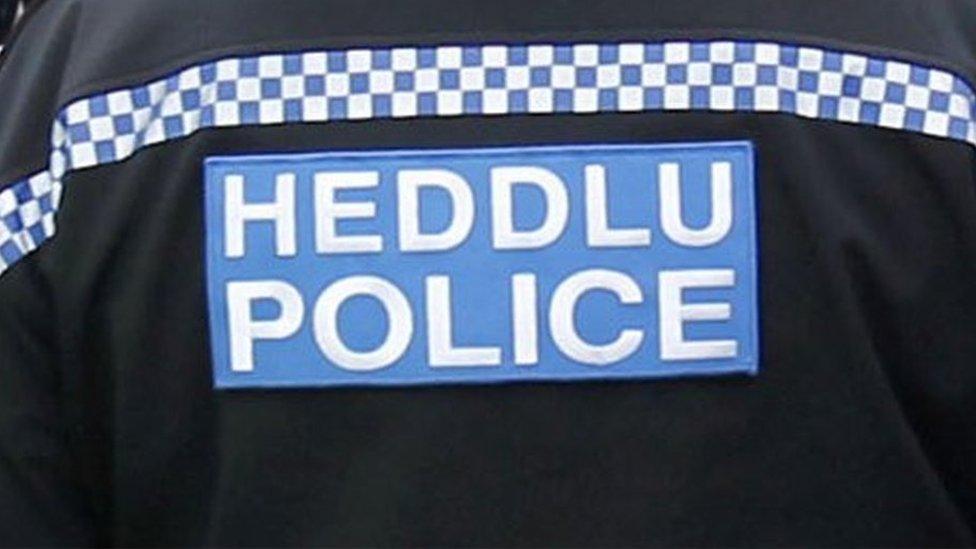
- Published26 December 2015
